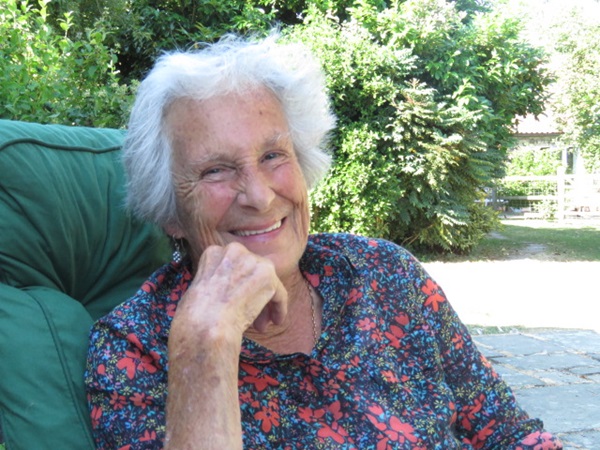
Obituary: K M Peyton
K M Peyton 1929 – 2023
K M Peyton remembered by Linda Newbery.
Kathleen Peyton, who died in December at 94, held the remarkable record of publishing across eight decades, beginning with Sabre, the Horse from the Sea under the name of Kathleen Herald when she was just 15. Best-known for Flambards, she’s sometimes referred to as a pony-book writer, a term that fails to do justice to the range of her work and its settings. Much-loved by readers, she also gave encouragement and support to several other writers including myself; our first meeting was at her home when I interviewed her for a Books for Keeps Authorgraph feature, and we were friends from then on.
The M of K M Peyton refers to Mike, her husband, with whom she produced serialised adventure stories in the late 1950s and early 60s, Mike providing cliff-hanger endings and Kathleen doing the writing. After a few years teaching art in Northampton, and the birth of daughters Hilary and Veronica, Kathleen continued as K M Peyton for the books she wrote alone. Recognition for her work included a New York Herald Tribune Award for The Maplin Bird, the Carnegie Medal for The Edge of the Cloud, the Guardian Children’s Fiction Prize for the Flambards trilogy (as it was before she added a fourth book, Flambards Divided, after an interval of twelve years), and the Children’s Book Award for Darkling. In 2014 she was made MBE for services to children’s literature. The Flambards trilogy was televised by Yorkshire TV and a stand-alone novel, A Pattern of Roses, was filmed, giving the young Helena Bonham Carter her first screen role.
Kathy’s gifts as an author are readily apparent. Her plots are compelling, her characters memorable; she excels at writing action, whether on horseback, at sea or in a flimsy aircraft, and her understanding of adolescent yearnings and frustrations leaps off the pages. What especially attracts me to her work is her depiction of scenery, landscapes, weather and light, which she draws economically but with a painterly eye. She wrote with enviable fluency, making it look easy; in our conversations she told me that she rarely spent much time revising her work.
The Flambards sequence covers a sweep of time from 1908 to the early 1920s, through the First World War and beyond. In the first book, twelve-year-old Christina, an orphan, is sent to live with her Uncle Russell and two cousins at Flambards in Essex. Her relationships with cousins Mark and Will, and the kindly groom, Dick, develop throughout the four books of the series. Under the harsh rule of Uncle Russell, life at Flambards is dominated by horses and fox-hunting, a sphere in which Christina soon finds herself at home. While Mark shares his father’s obsession, the younger son Will, intelligent and reserved, is far more socially aware, seeing the regime at Flambards as feudal. The novel ends in 1912 with Christina and Will running away together, symbolically from a hunt ball.
The Edge of the Cloud, which follows immediately, takes us into the exhilarating and perilous world of early flying, with the First World War looming; the final two novels return to Flambards and the difficulties of running a productive farm during wartime. Although we never visit the front line in these stories, Christina’s friend Dorothy, first introduced in The Edge of the Cloud, tells of the harrowing scenes she’s witnessed as a VAD nurse, and both Mark and Dick are deeply affected by their experiences; after the Armistice, the jazz age and new freedoms provide welcome relief as Christina’s relationships become ever more complicated.
In a quite different vein, Pennington’s Seventeenth Summer shows Kathy’s gift for humour and her sense of the absurd. An engagingly rebellious character on whom many a reader has had a crush, Patrick Pennington is a talented pianist whose career develops over another series of novels, combining with Ruth, heroine of one of Kathleen’s most typical pony stories, Fly-by-Night.
There were several adult novels too, of which I think Kathy’s favourite was Dear Fred, set in Victorian Newmarket, in which teenage Laura is obsessed with the champion jockey Fred Archer before finding loves of her own. Kathy felt that this had been published rather uncertainly, not a children’s book but not marketed for adults either; in recent years she hoped that it might be reissued.
Kathy will be remembered as a pioneer of young adult fiction in the 1970s and 80s, along with such other notable writers as Jean Ure, Robert Westall, Robert Cormier, Aidan Chambers and Jill Paton Walsh. A talented artist, she also provided cover images for several of her novels.
Linda Newbery is an author and environmental campaigner. Her novel The Key to Flambards, written with Kathleen Peyton’s approval, revisits Flambards in the 21st Century with Christina’s great-granddaughter as the main character.





